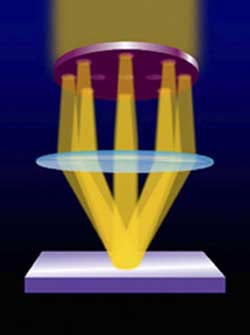Devising nano vision for an optical microscope

A new optical imaging technology under development at NIST will use combinations of dynamically controlled light waves, optimized for particular properties (such as polarization). How this structured illumination field -- engineered specifically to highlight the particular geometry of each type of specimen -- scatters after striking the target may reveal features smaller than 10 nanometers.
Contrary to conventional wisdom, technology’s advance into the vanishingly small realm of molecules and atoms may not be out of sight for the venerable optical microscope, after all. In fact, research at the National Institute of Standards and Technology (NIST) suggests that a hybrid version of the optical microscope might be able to image and measure features smaller than 10 nanometers–a tiny fraction of the wavelength of visible light.
In a preliminary test of the embryonic technique, NIST scientists used violet light with a wavelength of 436 nanometers to image features as small as 40 nanometers, about five times smaller than possible with a conventional optical microscope.
Roughly speaking, such a feat is akin to picking up a solitary dime with a clumsy front-end loader. If successfully developed, the imaging technology could be readily incorporated into chip-making and other commercial-scale processes for making parts and products with nanometer-scale dimensions.
The wavelengths of light in the visible part of the spectrum greatly exceed nanoscale dimensions. Consequently, the resolution of conventional light-based imaging methods is limited to about 200 nanometers–too large to resolve the details of nanotechnology, which, by definition, are no more than half that size.
However, a newly begun, five-year research effort at NIST suggests that a novel combination of illumination, detection and computing technologies can circumvent this limitation. Success would extend the technology’s 400-year-long record as an indispensable imaging and measurement tool well into the expanding realm of nanotechnology.
Called phase-sensitive, scatter-field optical imaging, the computer-intensive technique under development at NIST uses a set of dynamically engineered light waves optimized for particular properties (such as angular orientation and polarization). How this structured illumination field–engineered differently to highlight the particular geometry of each type of specimen–scatters after striking the target can reveal the tiniest of details.
“The scattering patterns are extremely sensitive to small changes in the shape and size of the scattering feature,” explains Rick Silver, a physicist in NIST’s Precision Engineering Division.
Media Contact
More Information:
http://www.nist.govAll latest news from the category: Physics and Astronomy
This area deals with the fundamental laws and building blocks of nature and how they interact, the properties and the behavior of matter, and research into space and time and their structures.
innovations-report provides in-depth reports and articles on subjects such as astrophysics, laser technologies, nuclear, quantum, particle and solid-state physics, nanotechnologies, planetary research and findings (Mars, Venus) and developments related to the Hubble Telescope.
Newest articles

Bringing bio-inspired robots to life
Nebraska researcher Eric Markvicka gets NSF CAREER Award to pursue manufacture of novel materials for soft robotics and stretchable electronics. Engineers are increasingly eager to develop robots that mimic the…

Bella moths use poison to attract mates
Scientists are closer to finding out how. Pyrrolizidine alkaloids are as bitter and toxic as they are hard to pronounce. They’re produced by several different types of plants and are…

AI tool creates ‘synthetic’ images of cells
…for enhanced microscopy analysis. Observing individual cells through microscopes can reveal a range of important cell biological phenomena that frequently play a role in human diseases, but the process of…





















